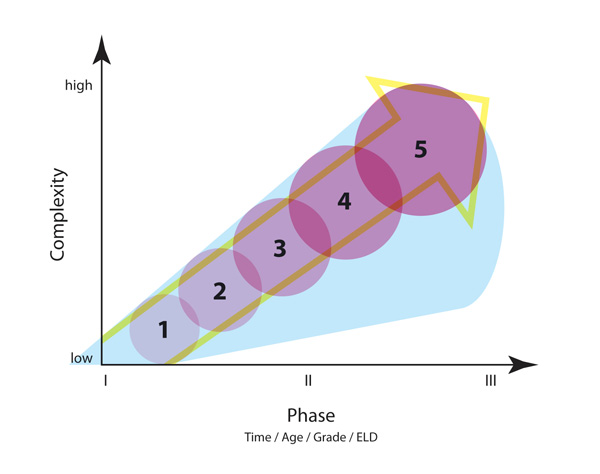Conceptualization of Dynamic Language Learning Progressions
Each progression is conceptualized to capture several key dimensions as shown in the graphic representation of a generic or hypothesized DLLP below. These dimensions are:
Y-axis: the increase in complexity of the language and discourse features of a given language function
X-axis: the successive phases of key contextualizing characteristics of the learner which change with experience, exposure, or maturation (e.g., increasing time in U.S. schooling, increasing age/grade, increasing degree of English Language Development (ELD) proficiency, if ELL, etc.)
The graphic places the dimension of complexity along a continuum from low to high.

The graphic illustrates how the dimensions related to experience, exposure, or maturation can be divided into any number of meaningful phases depending on which of the key characteristics is represented on the X-axis. Due to the limitations of two-dimensional representation in the graphic, these characteristics are portrayed as mutually exclusive options, but in reality there can be multiple characteristics operating simultaneously to influence learners’ trajectories along a DLLP.
The trajectory for the coordination of these dimensions is hypothesized to be linear and positive (i.e. from bottom left to top right in the graphic), indicating increasing complexity in language and discourse features as a function of experience, exposure or maturation.
Two further characteristics of DLLPs are also captured in the graphic:
(1) The increasing sizes of the five overlapping circles represent the increasing array of language and discourse features required for producing (orally or in print) a given language function. The constellation of features within a circle may be conceived of as “prototype” performances for a given language function and will be determined for each operational DLLP from actual student performances. The overlapping portions of the circles along the line of the DLLP trajectory represent the language and discourse features that may either temporarily co-occur at points along the trajectory of the developing language function, or are maintained across all successive phases of its development. That is, features acquired and displayed at an earlier phase may be carried over into a new phase and be combined with a new and wider array of features. It is an empirical question how many distinctive constellations (i.e., circles) of skills and knowledge there may be along a DLLP trajectory. The DLLP project will investigate the hypothesized relationships displayed in the current generic graphic for each progression created.
(2) Students using fewer or different features for their language functions (non-prototypical language performances) may deviate from the main trajectory of a DLLP as a function of such aspects as time in U.S. schooling, age/grade, degree of ELD proficiency, etc. This deviation is represented by the shaded fan overlaid on the generic DLLP graphic. The area of this fan is hypothesized to provide the space for individual pathways to emerge in the student performance data (cross-sectionally and longitudinally). While the DLLPs are hypothesized to be linear in nature for those who progress from the lowest levels of complexity in a language function and who are at the earliest phases of experience, exposure, and maturation, non-linear pathways to the upper sections of a DLLP by individuals or certain subgroups can also be readily accounted for. An individual may be placed on the DLLP at any point, including within the area of the fan. Even if there is asymmetry in contextual characteristics, a student’s current performance and his/her future learning needs can be easily located in relation to the overall trajectory of the DLLP.
An Extended Example with the DLLP for Explanation
A new-comer, beginning ELL student in 9th grade would be placed at Phase III along the X-axis based on his/her age, grade, and assumed cognitive development. The student will likely be producing explanations in English characterized by low complexity in linguistic and discourse features.
By situating the student’s current performance on the DLLP for the explanation language function (i.e., low on the y-axis) and locating where the student is expected to operate by Phase III to access content classes without language supports (i.e., high on x-axis) the DLLP permits us to identify two aspects of the student’s language learning needs: 1) the intervening constellation of features that the student will need to acquire, and 2) the magnitude (or extent) of the learning that will need to occur to reach age/grade-level expectations.
The DLLPs are dynamic and can take account of multiple dimensions on the X-axis. This means that when another set of contextual factors places the student at Phase I (e.g., time in U.S. schooling and ELD level) we are able to project along the DLLP a second time (or third or fourth time depending on the number of additional contextual characteristics) from the earliest levels of explanations produced by students with similar contextual characteristics. In this way, DLLPs can build our knowledge of where a student is placed along a trajectory, why they are so placed, and what further incremental and precursor skills this student may need to collectively inform an instructional response to advance language learning.
